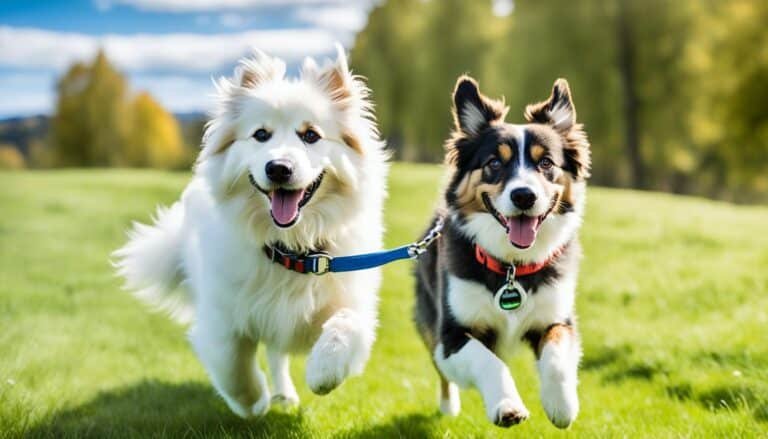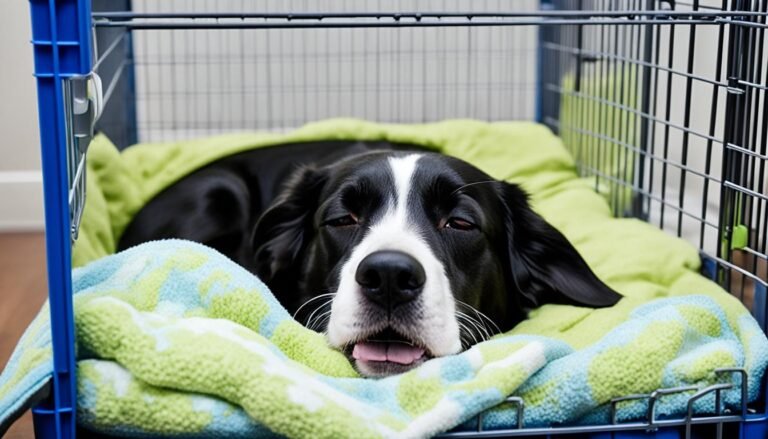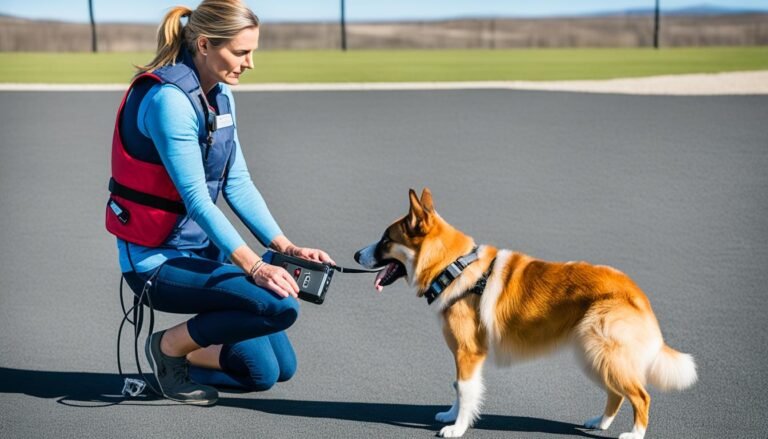How to Train a Dog to Be Calm
Is your dog constantly running around, jumping on furniture, and barking at every little noise? It can be frustrating to have a hyperactive dog that never seems to calm down. But don’t worry, there are effective techniques to help you train your dog to be calm and well-behaved.
Meet Bella, a lovable but overly energetic Golden Retriever. Bella was always full of energy, constantly chasing her tail and bounding around the house. Her owner, Sarah, knew she needed to find a way to help Bella relax and become more focused.
After researching dog calm training tips, Sarah discovered a variety of techniques that could help Bella find her inner zen. She realized that addressing the root causes of Bella’s hyperactivity, such as anxiety and lack of exercise, was crucial to achieving long-term calmness.
One of the first things Sarah did was to provide Bella with more attention and mental stimulation. She spent quality time playing with Bella, engaging her in puzzle toys, and teaching her new tricks. Gradually, she noticed that Bella’s hyperactivity began to subside as she received the love and mental stimulation she needed.
Realizing the importance of early training, Sarah also started obedience training at a young age. By establishing herself as the pack leader and teaching Bella to follow commands, Sarah created a secure foundation for Bella to develop good behavior and remain calm in any situation.
In addition, Sarah incorporated detox training into their daily walks. By gradually exposing Bella to distractions and reinforcing calm behavior, Sarah prevented overexcitement on the leash and helped Bella remain calm and focused during their walks.
Regular exercise also played a significant role in Bella’s transformation. Sarah made sure Bella had plenty of opportunities to release her excess energy through walks, runs, and playtime. By harnessing Bella’s energy in a positive way, Sarah prevented anxiety and bad behavior, leading to a much calmer pup.
But it wasn’t just physical exercise that made a difference. Sarah also discovered the power of mental stimulation. Through mind games, obstacle courses, and attending dog training classes, Sarah challenged Bella’s cognitive abilities and tired out her mind. This combination of mental and physical exercise worked wonders in promoting a calm and well-balanced dog.
Understanding Bella’s body language was also crucial in their training journey. Sarah learned to observe Bella’s stance, eyes, ears, and sounds to gauge her emotions and adjust their training approach accordingly. This allowed them to communicate effectively and make sure Bella felt understood and supported.
Lastly, Sarah embraced the power of positive reinforcement. Whenever Bella exhibited calm and desired behavior, Sarah rewarded her with treats, praise, and toys. This positive reinforcement helped Bella understand what Sarah expected from her and encouraged her to continue behaving calmly.
Can you imagine the joy Sarah felt when she saw Bella grow into a calm and well-behaved dog? By implementing these techniques, Sarah was able to transform her hyperactive pup into a model of canine calmness.
In the following sections, we will delve deeper into these techniques and provide you with all the information you need to train your own dog to be calm. Let’s get started!
Addressing Attention Deficits: The Key to Calm
One common cause of hyperactivity in dogs is a lack of attention. Dogs require physical and mental stimulation to stay happy and well-adjusted. If your dog is hyperactive, it may be a sign that it is not getting enough attention and stimulation.
Take an honest look at how much time you are spending with your dog and consider if it is enough to meet its needs. Increasing the amount of quality time you spend with your dog can help address attention deficits and promote calm behavior.
Dogs thrive on love and human interaction. They need plenty of love, care, and attention to feel secure and content. By giving your pet the love it needs, you can help alleviate hyperactivity and create a peaceful environment for both you and your furry friend.
Additionally, lack of mental stimulation can also contribute to a hyperactive dog. Dogs are intelligent creatures that require mental challenges to keep their minds sharp. Engaging your dog in activities that stimulate their brain, such as puzzle toys or training sessions, can provide the mental exercise they need.
Provide Physical and Mental Stimulation
- Take your dog for regular walks or play fetch in the park to provide physical exercise.
- Engage in interactive play sessions, such as tug-of-war or hide-and-seek, to keep your dog mentally stimulated.
- Consider enrolling your dog in obedience classes or agility training to give them a job to focus on.
- Introduce new toys or rotate them regularly to keep your dog’s interest and prevent boredom.
- Set up obstacle courses or scavenger hunts to challenge your dog’s problem-solving abilities.
Remember, a hyperactive dog is often a bored dog. By addressing attention deficits and providing the right amount of physical and mental stimulation, you can help your dog become calmer and more well-behaved.
Laying the Foundation: Early Training Matters
When it comes to training your dog to be calm and well-behaved, early training is key. Dogs are pack animals, and they thrive when they have a task to perform and a leader to please. By providing obedience training from an early age, you can lay the foundation for regulating your dog’s behavior and teaching them to follow commands.
Obedience training establishes you as the pack leader, which helps your dog feel secure and confident. It teaches them to look to you for guidance and helps them understand their role within the family. With consistent training, your dog will develop good behavior and understand what is expected of them in various situations.
During obedience training, your dog will learn essential commands such as sit, stay, come, and leave it. These commands not only help regulate their behavior but also ensure their safety. Knowing these commands gives you the ability to control your dog’s actions and prevent them from engaging in potentially dangerous situations.
Additionally, early training helps create a strong bond between you and your dog. By working together through training sessions, you build trust, communication, and mutual respect. This bond will contribute to their overall well-being and make it easier to calm them down in any situation.
Remember, consistency is crucial during the training process. Practice the commands regularly, provide positive reinforcement when your dog responds correctly, and be patient. Training takes time and effort but is well worth it for a well-behaved and calm furry companion.
Try Detox Training to Prevent Over Excitement on a Leash
If your dog tends to get overexcited while on a leash, it can make walks stressful and challenging. Detox training is a technique that can help you prevent over excitement and promote calmness during leash walks.
To start with detox training, you’ll need a sturdy leash and a calm environment with minimal distractions. Begin by practicing inside your home or in a quiet outdoor area. Attach the leash to your dog’s collar or harness, and hold the other end firmly in your hand.
Start walking slowly and calmly, ensuring there is a slight tension on the leash. If your dog starts to pull or show signs of overexcitement, stop walking immediately and stand still. Ignore any attempts your dog makes to move forward or pull towards a stimulus.
Once your dog has settled and calmed down, resume walking. If your dog starts to pull again, repeat the process of stopping and waiting for them to calm down.
Gradually introduce distractions into your training sessions. This can include passing by other dogs, people, or stimulating environments. The key is to remain calm and consistent in your response to your dog’s behavior.
Reinforce your dog’s calmness with rewards, such as treats or verbal praise, when they remain composed and focused on the leash. This positive reinforcement will help them associate calm behavior with positive outcomes.
Remember, consistency is crucial in detox training. It may take time for your dog to understand and adapt to this new approach, so be patient and persistent. With consistent training sessions, your dog will learn to remain calm on a leash and avoid overexcitement.
Detox training is a powerful tool for preventing over excitement and eliminating undesirable behaviors during leash walks. Incorporate this technique into your training routine to ensure enjoyable and stress-free walks with your furry companion.
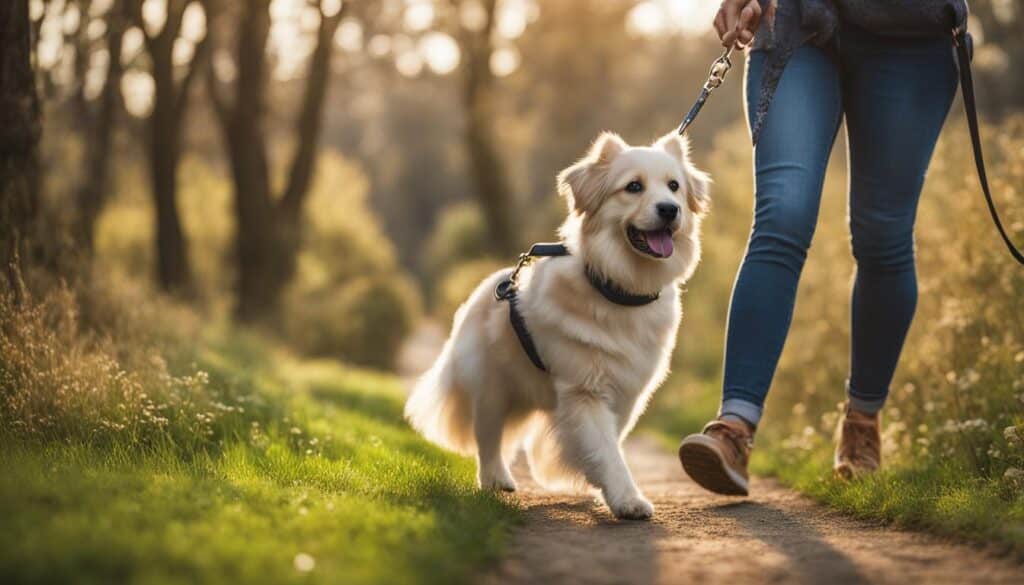
Harness Energy: The Power of Regular Exercise
In order to keep your dog calm and well-balanced, regular exercise is key. By engaging your dog in physical activities, you can help them release excess energy, prevent anxiety, and avoid bad behavior. Here are some tips to help you harness the power of regular exercise:
- Take your dog for regular walks: Daily walks are a great way to provide exercise and mental stimulation for your furry friend. Aim for at least 30 minutes to an hour of brisk walking to burn off excess energy.
- Engage in active playtime: Play fetch, tug-of-war, or use interactive toys to keep your dog active and entertained. This not only helps them burn off energy but also strengthens the bond between you and your dog.
- Consider agility training: If your dog enjoys physical challenges, agility training can be a fun and effective way to exercise both their body and mind. Set up an obstacle course in your backyard or join a local agility class.
- Try swimming: Swimming is a low-impact exercise that is gentle on your dog’s joints while providing a full-body workout. If your dog enjoys the water, take them for a swim at a dog-friendly beach or pool.
- Explore new environments: Take your dog on hikes or explore different parks and trails. The change of scenery and smells will keep them mentally stimulated and engaged.
Remember, every dog’s exercise needs are different, so adapt the activities based on your dog’s breed, age, and overall health. Regular exercise not only helps wear out your dog physically but also promotes mental well-being, preventing anxiety and bad behavior. So make sure to prioritize regular exercise as an essential part of your dog’s daily routine!
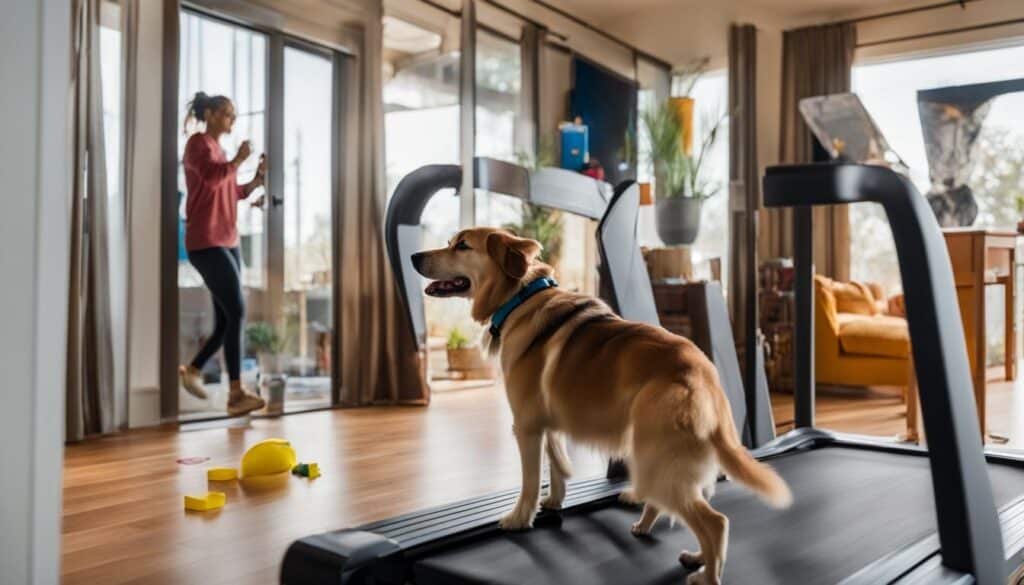
Mind Games: Boosting Your Dog’s Cognitive Control
In addition to physical exercise, providing your dog with mental stimulation is key to keeping them calm and well-behaved. Just like humans, dogs need to exercise their brains too. Engaging your dog in mind games and mental exercises can tire out their mind and promote calm behavior. Here are some effective strategies to boost your dog’s cognitive control:
1. Obstacle Courses
Set up obstacle courses in your backyard or living space to challenge your dog’s problem-solving skills and coordination. Use objects like cones, tunnels, and hoops for them to navigate through. This not only provides mental stimulation but also helps your dog stay physically fit.
2. Hiding Treats
Hide treats around your home or in a specific area and encourage your dog to find them. This activity engages their scenting abilities and encourages them to use their brain to search for the hidden rewards. Start with easy hiding spots and gradually increase the difficulty level as your dog becomes more proficient.
3. Dog Training Classes
Enroll your dog in training classes that focus on cognitive stimulation. These classes provide structured mental exercises and challenges that help strengthen your dog’s cognitive abilities. Plus, your dog will have the opportunity to socialize with other dogs, which can contribute to their overall well-being.
By incorporating these mind games and activities into your dog’s routine, you can keep their mind sharp, reduce boredom, and promote calm behavior. Remember, a tired and stimulated mind is a well-behaved mind!
Learn Your Dog’s Body Language
Understanding your dog’s body language is crucial for effectively training them. Dogs communicate their emotions and intentions through various physical cues, including their stance, eyes, ears, and sounds. By observing and interpreting these signals, you can gauge your dog’s response to training sessions and make necessary adjustments to ensure a successful training experience.
Observing Stance
Pay attention to your dog’s stance during training. A relaxed and balanced stance indicates a calm and receptive state, while a tense or stiff body posture may suggest anxiety or discomfort. By identifying signs of stress or relaxation in your dog’s stance, you can adapt your training methods accordingly to create a positive and comfortable learning environment.
Reading Eyes and Ears
The eyes and ears of a dog provide valuable insights into their emotional state. Wide, alert eyes and erect, forward-facing ears typically indicate focus and attentiveness. Conversely, squinting eyes or pinned-back ears may indicate fear, stress, or aggression. By studying these visual cues, you can better understand your dog’s reactions and emotions, promoting effective training outcomes.
Decoding Sounds
Dogs communicate through a range of vocalizations, including barks, growls, whines, and howls. Each sound carries its own meaning and signifies different emotions. By listening to the nuances of your dog’s vocalizations, you can gain insight into their feelings and tailor your training approach accordingly. Pay attention to the pitch, tone, and intensity of their vocalizations to gauge their response to training cues.
By learning to understand and interpret your dog’s body language, you can enhance your training sessions and strengthen the bond between you and your furry companion. Remember, every dog is unique, so take the time to observe and learn the specific cues that your dog exhibits. This will enable you to gauge their response to training, address their needs effectively, and foster a calm and cooperative learning environment.
Use Positive Reinforcement for Good Behavior
Positive reinforcement is a powerful tool for training your dog to be calm and well-behaved. Whenever your furry friend exhibits good behavior, it’s important to reward them in a way that they find motivating. This can be done through treats, praise, or even their favorite toys. By associating their good behavior with positive outcomes, you are reinforcing the desired behavior and increasing the likelihood of them repeating it.
On the other hand, it is equally important to ignore or redirect any bad behavior that your dog may display. By not giving attention to unwanted actions, you avoid inadvertently reinforcing them. Instead, focus your attention and energy on highlighting and rewarding the behaviors that you want to see more of.
Consistency is key when using positive reinforcement. Make sure to consistently reward your dog’s good behavior and consistently redirect or ignore any undesirable behavior. This will help your dog understand what is expected of them and reinforce the idea that calm and well-behaved behavior is rewarded.
Remember, positive reinforcement is an effective and humane way to train your dog. By using rewards and positive reinforcement, you are creating a bond of trust and understanding between you and your furry companion, making the training process enjoyable and rewarding for both of you.

